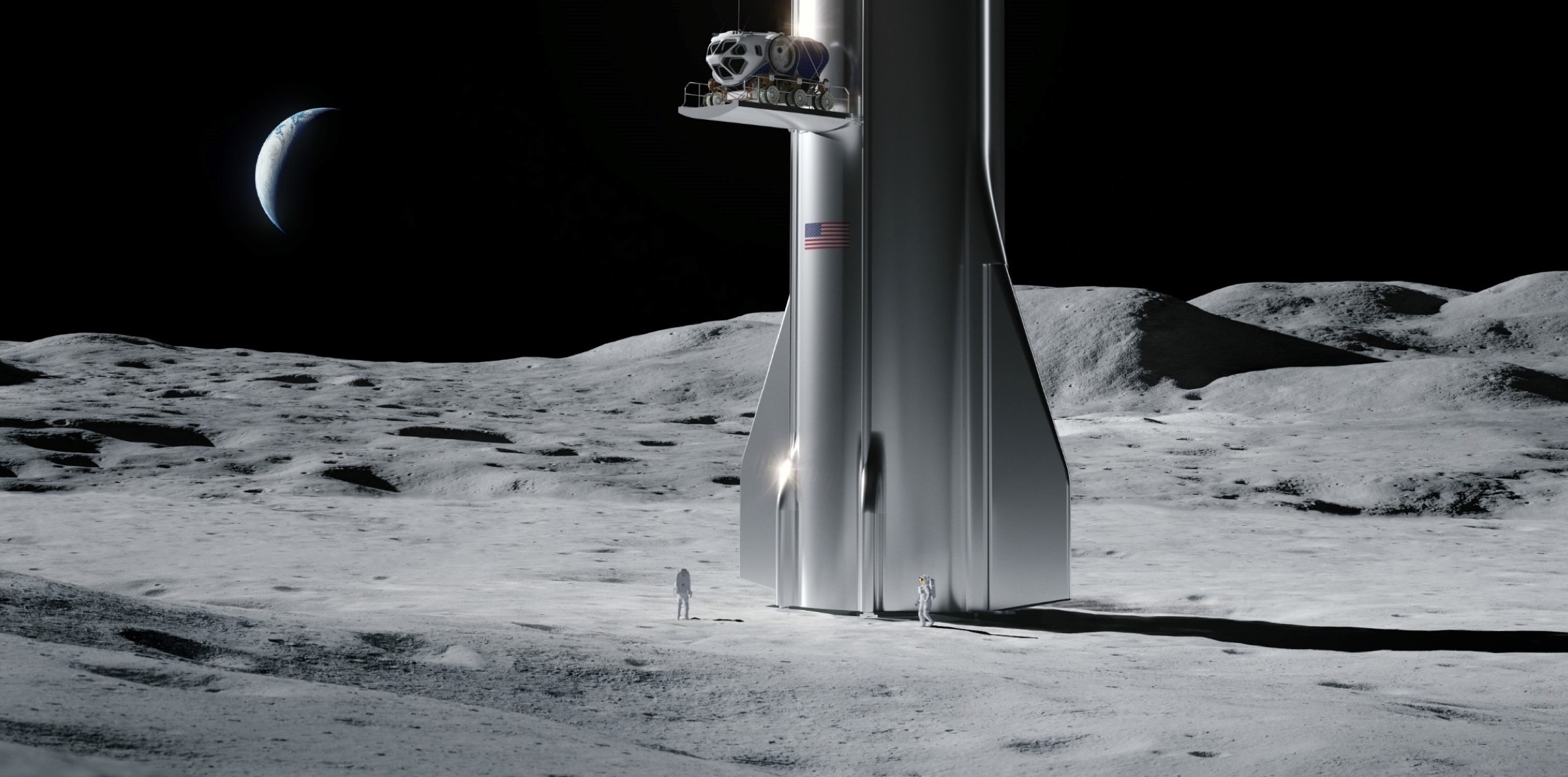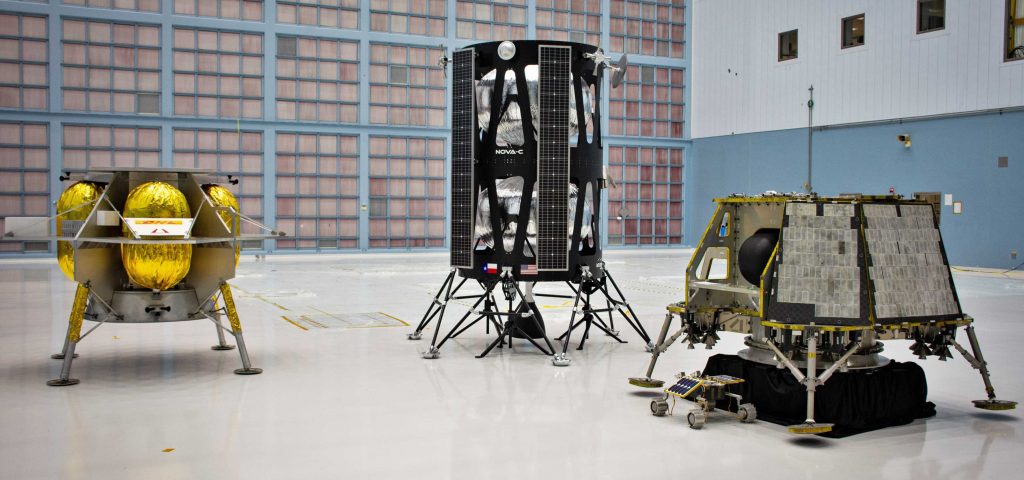

News
SpaceX’s Starship to spar with Blue Origin for NASA Moon landing contracts
On November 18th, NASA announced that it had added commercial Moon lander offerings from SpaceX, Blue Origin, Sierra Nevada Corporation, and others to a pool of companies that will be able to compete to affordably deliver cargo to the surface of the Moon. With this latest addition of landers, competition could get very interesting, very quickly.
In November 2018, NASA revealed a big step forward in its plans to kickstart robotic exploration and utilization of the Moon, announcing nine new partners in its Commercial Lunar Payload Services (CLPS) initiative. Designed first and foremost to encourage the commercial development of unprecedentedly affordable Moon landers, the program’s first nine partners included Lockheed Martin, Astrobotic, Intuitive Machines, Masten Space, Orbit Beyond, and several others.
In May 2019, NASA announced the next step, contracting with three of those nine aforementioned providers to bring their proposed Moon landers to fruition and attempt their first lunar landings. Orbit Beyond dropped out shortly after but Astrobotic and Intuitive Machines continue to work towards that goal and aim to attempt the first Moon landings with their respective Peregrine and Nova-C spacecraft no earlier than (NET) July 2021. Intuitive Machines has contracted a SpaceX Falcon 9 for its first Nova-C Moon launch, while Astrobotic side with the very first launch of United Launch Alliance’s (ULA) next-generation Vulcan rocket.

Generally speaking, the landers offered by the first nine CLPS partners were on the smaller side of the spectrum, capable of delivering around 50-100 kg (100-200 lb) of useful cargo to the surface of the Moon with launch masses around 1500-3000 kg (3300-6600 lb). On November 18th, NASA announced that a second group of partners would be added to the competitive ‘pool’ of CLPS-eligible Moon landers, all of which can technically compete to land a range of NASA payloads on the Moon. The new five are Ceres Robotics, Tyvak Nano-Satellite Systems, Sierra Nevada Corporation, Blue Origin, and SpaceX.
Next to nothing is known about Tyvak’s or Ceres Robotics’ apparently proposed landers, but a render of SNC’s Moon lander concept shares some obvious similarities with its Dream Chaser spacecraft and expendable power and propulsion module, implying that it’s likely on the larger side. Blue Origin and SpaceX, of course, proposed their Blue Moon and Starship spacecraft.


As a 100%-speculative guess, Ceres and Tyvak’s landers are likely in the same ~100 kg-class range as the nine CLPS providers selected before it, while Sierra Nevada’s lander concept is probably closer to 500 kg (1100 lb). According to Blue Origin, it’s recently-updated Blue Moon lander is designed to deliver up to 4500 kg (9900 lb) to the lunar surface and is expected to attempt its first Moon landing no earlier than 2024.
Unsurprisingly, SpaceX’s Starship blows all 13 other lander proposals out of the water and, in the context of the CLPS program, is a bit like bringing a Gatling gun to a paintball match. According to SpaceX, a fully-refueled Starship should be able to land 100 metric tons (220,000 lb) of cargo on the Moon, although it’s unclear if that would allow the Starship to return to Earth.

In simpler terms, there is just no chance whatsoever that the practical scope of NASA’s CLPS program could possibly warrant more than a few metric tons delivered to the surface of the Moon. NASA as a whole doesn’t have the budget needed to build useful several-dozen-ton spacecraft or experiments, let alone CLPS. In that sense, the real question to ask is what could Starship manage if the useful payloads it needs to deliver are no more than a few metric tons?
Assuming SpaceX’s technical know-how is mature enough to allow Starship to preserve cryogenic propellant for weeks or months after launch, it’s entirely conceivable that a Moon launch with, say, 10 tons of cargo could be achieved with just one or two in-orbit refuelings, all while leaving that Starship enough margin to safely return to Earth. Given that NASA awarded Intuitive Machines and Astrobotic approximately $80M apiece to land 50-100 kg on the Moon, it’s far too easy to imagine SpaceX quoting a similar price to deliver 10+ tons to the Moon by enabling full Starship reuse.
All things considered, politics still looms in the distance and there is just as much of a chance that SpaceX (and maybe even Blue Origin) will be passed over by CLPS when the time comes to award the next round of Moon delivery contracts. Still, the odds of something far out of the ordinary happening are much higher with a program like CLPS. Stay tuned!
Check out Teslarati’s Marketplace! We offer Tesla accessories, including for the Tesla Cybertruck and Tesla Model 3.

News
Tesla FSD v14.2.2 is getting rave reviews from drivers
So far, early testers have reported buttery-smooth drives with confident performance, even at night or on twisty roads.

Tesla Full Self-Driving (Supervised) v14.2.2 is receiving positive reviews from owners, with several drivers praising the build’s lack of hesitation during lane changes and its smoother decision-making, among others.
The update, which started rolling out on Monday, also adds features like dynamic arrival pin adjustment. So far, early testers have reported buttery-smooth drives with confident performance, even at night or on twisty roads.
Owners highlight major improvements
Longtime Tesla owner and FSD user @BLKMDL3 shared a detailed 10-hour impression of FSD v14.2.2, noting that the system exhibited “zero lane change hesitation” and “extremely refined” lane choices. He praised Mad Max mode’s performance, stellar parking in locations including ticket dispensers, and impressive canyon runs even in dark conditions.
Fellow FSD user Dan Burkland reported an hour of FSD v14.2.2’s nighttime driving with “zero hesitations” and “buttery smooth” confidence reminiscent of Robotaxi rides in areas such as Austin, Texas. Veteran FSD user Whole Mars Catalog also demonstrated voice navigation via Grok, while Tesla owner Devin Olsen completed a nearly two-hour drive with FSD v14.2.2 in heavy traffic and rain with strong performance.
Closer to unsupervised
FSD has been receiving rave reviews, even from Tesla’s competitors. Xpeng CEO He Xiaopeng, for one, offered fresh praise for FSD v14.2 after visiting Silicon Valley. Following extended test drives of Tesla vehicles running the latest FSD software, He stated that the system has made major strides, reinforcing his view that Tesla’s approach to autonomy is indeed the proper path towards autonomy.
According to He, Tesla’s FSD has evolved from a smooth Level 2 advanced driver assistance system into what he described as a “near-Level 4” experience in terms of capabilities. While acknowledging that areas of improvement are still present, the Xpeng CEO stated that FSD’s current iteration significantly surpasses last year’s capabilities. He also reiterated his belief that Tesla’s strategy of using the same autonomous software and hardware architecture across private vehicles and robotaxis is the right long-term approach, as it would allow users to bypass intermediate autonomy stages and move closer to Level 4 functionality.
News
Elon Musk’s Grok AI to be used in U.S. War Department’s bespoke AI platform
The partnership aims to provide advanced capabilities to 3 million military and civilian personnel.

The U.S. Department of War announced Monday an agreement with Elon Musk’s xAI to embed the company’s frontier artificial intelligence systems, powered by the Grok family of models, into the department’s bespoke AI platform GenAI.mil.
The partnership aims to provide advanced capabilities to 3 million military and civilian personnel, with initial deployment targeted for early 2026 at Impact Level 5 (IL5) for secure handling of Controlled Unclassified Information.
xAI Integration
As noted by the War Department’s press release, GenAI.mil, its bespoke AI platform, will gain xAI for the Government’s suite of tools, which enable real-time global insights from the X platform for “decisive information advantage.” The rollout builds on xAI’s July launch of products for U.S. government customers, including federal, state, local, and national security use cases.
“Targeted for initial deployment in early 2026, this integration will allow all military and civilian personnel to use xAI’s capabilities at Impact Level 5 (IL5), enabling the secure handling of Controlled Unclassified Information (CUI) in daily workflows. Users will also gain access to real‑time global insights from the X platform, providing War Department personnel with a decisive information advantage,” the Department of War wrote in a press release.
Strategic advantages
The deal marks another step in the Department of War’s efforts to use cutting-edge AI in its operations. xAI, for its part, highlighted that its tools can support administrative tasks at the federal, state and local levels, as well as “critical mission use cases” at the front line of military operations.
“The War Department will continue scaling an AI ecosystem built for speed, security, and decision superiority. Newly IL5-certified capabilities will empower every aspect of the Department’s workforce, turning AI into a daily operational asset. This announcement marks another milestone in America’s AI revolution, and the War Department is driving that momentum forward,” the War Department noted.
News
Tesla FSD (Supervised) v14.2.2 starts rolling out
The update focuses on smoother real-world performance, better obstacle awareness, and precise end-of-trip routing, among other improvements.

Tesla has started rolling out Full Self-Driving (Supervised) v14.2.2, bringing further refinements to its most advanced driver-assist system. The new FSD update focuses on smoother real-world performance, better obstacle awareness, and precise end-of-trip routing, among other improvements.
Key FSD v14.2.2 improvements
As noted by Not a Tesla App, FSD v14.2.2 upgrades the vision encoder neural network with higher resolution features, enhancing detection of emergency vehicles, road obstacles, and human gestures. New Arrival Options let users select preferred drop-off styles, such as Parking Lot, Street, Driveway, Parking Garage, or Curbside, with the navigation pin automatically adjusting to the user’s ideal spot for precision.
Other additions include pulling over for emergency vehicles, real-time vision-based detours for blocked roads, improved gate and debris handling, and extreme Speed Profiles for customized driving styles. Reliability gains cover fault recovery, residue alerts on the windshield, and automatic narrow-field camera washing for new 2026 Model Y units.
FSD v14.2.2 also boosts unprotected turns, lane changes, cut-ins, and school bus scenarios, among other things. Tesla also noted that users’ FSD statistics will be saved under Controls > Autopilot, which should help drivers easily view how much they are using FSD in their daily drives.
Key FSD v14.2.2 release notes
Full Self-Driving (Supervised) v14.2.2 includes:
- Upgraded the neural network vision encoder, leveraging higher resolution features to further improve scenarios like handling emergency vehicles, obstacles on the road, and human gestures.
- Added Arrival Options for you to select where FSD should park: in a Parking Lot, on the Street, in a Driveway, in a Parking Garage, or at the Curbside.
- Added handling to pull over or yield for emergency vehicles (e.g. police cars, fire trucks, ambulances).
- Added navigation and routing into the vision-based neural network for real-time handling of blocked roads and detours.
- Added additional Speed Profile to further customize driving style preference.
- Improved handling for static and dynamic gates.
- Improved offsetting for road debris (e.g. tires, tree branches, boxes).
- Improve handling of several scenarios, including unprotected turns, lane changes, vehicle cut-ins, and school buses.
- Improved FSD’s ability to manage system faults and recover smoothly from degraded operation for enhanced reliability.
- Added alerting for residue build-up on interior windshield that may impact front camera visibility. If affected, visit Service for cleaning!
- Added automatic narrow field washing to provide rapid and efficient front camera self-cleaning, and optimize aerodynamics wash at higher vehicle speed.
- Camera visibility can lead to increased attention monitoring sensitivity.
Upcoming Improvements:
- Overall smoothness and sentience.
- Parking spot selection and parking quality.








